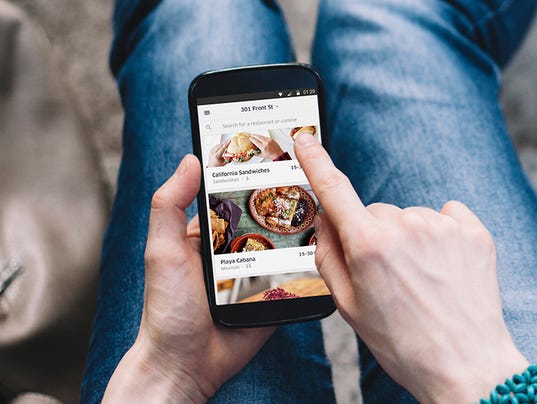
NEW YORK — Next time you get into an Uber, the car's last passenger may have been a carton of Thai curry.
As UberEats launches as a standalone app this month in 10 U.S. cities — including in New York and Washington D.C., on Tuesday — it's expanding its fleet of drivers, adding bike couriers and partnering with hundreds of restaurants to dig deeper into the competitive business of food delivery.
Uber is going up against established delivery companies like Seamless, Grubhub and Yelp's Eat24, plus smaller local companies like New York City's Maple in the fight for customers who are shunning their kitchens in favor of prepared meals delivered to their door. It's a $15.3 billion market, and one that's only getting bigger. Delivery represents 3% of 61 billion restaurant visits per year, according to NPD Group figures.
The expanded UberEats has Uber partnering with more than 100 restaurants in each city — which by the end of the month will include New York, Washington D.C., Atlanta, Houston, Dallas, Austin, Seattle, Chicago, Los Angeles and San Francisco. Traditional Uber features are still baked in: you can track your driver — or biker — as your meal makes its way to you on a live map and existing customers will find their payment information automatically transferred over from the Uber app.
The new app, which Uber began testing in Toronto in December, allows customers, for the most part, to order from the restaurants' full menus. It's an expansion of the more limited UberEats service, which has been around since 2014 within the original Uber app and offers two to five meals that restaurants prepare early in the day so they're available for delivery immediately. That's still an option in the app under "instant delivery."
Drivers will have to log into UberEats separately to pick up and deliver food orders, and log off and back in to the regular Uber app to start giving rides again, says spokeswoman Sarah Maxwell. And in some cities, like New York, your lunch will come courtesy of a bike messenger instead of a sleek black car.
Uber built a web-based dashboard for restaurants to track incoming orders and to dispatch couriers based on how long the restaurant says it will take to prepare a certain meal, which can be updated in real time.
Uber promises to have you fed in under an hour — delivery times around lunch time in New York on Tuesday ranged from 10 minutes to 51 minutes. Although it appears the company is still working out how to accurately determine wait times when demand spikes. Before I ordered lunch Tuesday around 12:30, I was told to expect a 15-26 minute delivery window. After I placed my order, the estimated delivery time was for 50 minutes later.
It's a glitch Uber will need to act quickly to address, because speed is ultimately the key to winning over customers in the increasingly crowded delivery market, says Kevin Kopelman, senior analyst with research firm Cowen and Co.
"It’s all about speed, quality and price," he says. "The faster you can get the deliveries done, the cheaper you can make it for customers because it means you can more effectively use delivery peoples’ time and they can do more delivery drops per hour." And it will help avoid the anger of hungry customers.
Uber is waiving the delivery fee in new markets for now but eventually will charge, though it hasn't announced how much. Toronto and Los Angeles, the first two markets to get the app, charge a $5 delivery fee.
Some of Uber's competitors have been chewed up and spit out, unable to keep up with the cost of doing business. Bay Area delivery app, SpoonRocket, shut down last week, citing "intense competition" and "an ever tightening funding environment."
Another San Francisco company, Sidecar, folded at the end of 2015 when it sold its assets to General Motors. The ride-sharing and delivery service had partnered with Eat24, a delivery service owned by Yelp, to double up on food deliveries and rides at the same time. That meant food orders could be riding along in the trunk during someone's drive, a model Sidecar had said was more efficient and affordable. But ultimately, it didn't work out.
"It’s harder for a smaller company to get the new customer, to get the restaurant partner on board or to get the scale necessary to make this work," Kopelman says.
But Uber enters the game with some sizable assets: More than 19 million customers and 400,000 active drivers to target for food orders.
"They have a history of very strong, smart, aggressive competition," Kopelman says, "so you have to take them seriously."



